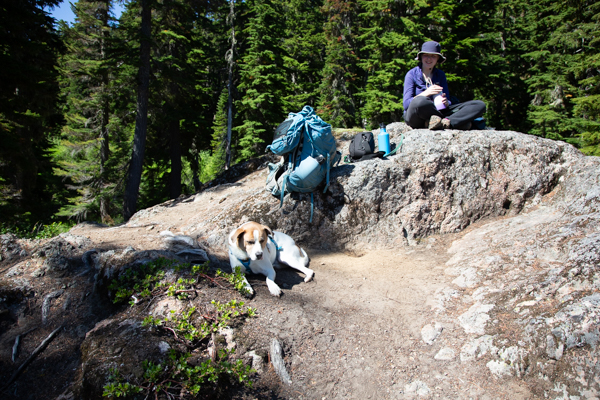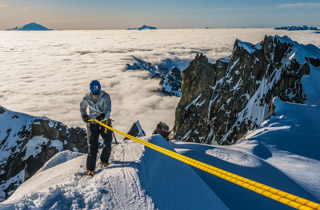Back-to-Back Training
Back-to-Back Training
Back-to-Backs: The Basics
One of the elements we address throughout our book, The Outdoor Athlete (Human Kinetics: 2009) is the importance of including Back-to-Backs in programs designed for any multi-day adventure. In this article, we explore the basics of who, what, when, where, why, and how to do them for your sport.
Anyone who will be participating in multi-day trekking, backpacking, mountaineering, or climbing adventures with at least two consecutive days of pack carrying during their trip should include several back-to-backs in their training. This would also include anyone who wants to do several single-day hikes with a pack heavier than 10 pounds on successive days from a single launch point.
Not only does this prepare the body physiologically, but it also helps you be psychologically and mentally prepared to carry a pack on successive days without having to rest. Without practicing this basic overnight travel skill, you might find it shocking when you have to do it on a trip. Prepare now, enjoy later.


Why and What?
Most training programs for foot travel will include gradually increasing hiking challenges of no more than a 10% increase in distance or pack weight per week. However, in order to properly prepare the body and mind for consecutive days of hard training, you need to simulate that training by carrying a pack two or more days in a row. That way you will learn how to work on less rest, even though you may feel a little sore or tired. By having that experience in training, a) your body won’t be quite as shocked when you ask it to do so again on an adventure, and b) you will already have done it a few times and the initial fatigue and soreness will be less on your trip. Knowing psychologically that you can work through it is a big boost to your confidence and morale, and far safer on the body if you’ve trained it to do so beforehand.
A Back-to-back is exactly what it sounds like. You’ll carry a pack on one day for a half-day hike, and then with no recovery day between them, you’ll hike again on the following day. Keep in mind that you do not have to exactly duplicate the elevation change and distance of your target adventure (i.e. finding terrain that allows 5000’ of gain on the first day and 4200’ of gain the second day at altitude can only be done on substantial peaks such as Mt. Rainier). However, carrying slightly more weight and covering less elevation gain or distance, carrying slightly less weight but going for more distance, or covering more elevation in less distance (steeper) with equal weight will do as much for you as duplicating your target adventure specifications.
Where?
If you live somewhere where ready access to elevation change is more difficult (i.e. Florida or Texas) you can do one day with a heavier pack on uphill-climbing gym equipment to get as much of your elevation as possible (i.e. high ramp treadmill, elliptical cross-trainer, Stairmaster, step mill, stairs or stadiums) and the second day with a lighter pack for greater distance, on as much varied terrain outside as you can find – whether that’s beach, grass, sand or gravel walking, a route that includes stairwells and on-ramps. Alpine outings such as climbs of glaciated peaks typically involve heavier approach and overnight camp packs and lighter summit packs for a long second day. Backpacking trips typically involve heavier first-day packs, and, as you consume food (i.e. eat some of the weight) the pack gets lighter with each passing day.
When?
The best time to start Back-to-Back training is deep into your program, about 4-6 weeks from your adventure, after you have built a good tolerance to heavier pack weights and solid strength endurance in your legs, core, and back muscles. If you have time and have had a long training ramp-up, do your first Back-to-Back weekend 6 weeks before your trip to test out your gear and recovery capacity, then another 4 weeks out and a final test no closer than 2 weeks before your trip. Your final heavy hike should be at least one week ahead of your trip, a single-day hike with all your gear, and then allow for a recovery taper during the week leading up to departure.
How?
Excerpt from The Outdoor Athlete (Human Kinetics: 2009), Ch. 8
“…include at least 1 or 2 back-to-back workouts with a pack if you are considering a multiday trip. Complete your final back-to-back outing no closer than 2 weeks before your trip so you have adequate recovery time. Make the day before your back-to-back conditioner an off day or a low-intensity cross-training cardiovascular workout to help you prepare your mind for the trip and keep your muscles limber. Include a rest or recovery day following a back-to-back conditioning bout. If on your goal outing, you will be carrying a heavy pack for five or more days, gradually work up to carrying 10 percent more weight for several hours on end at least 2 days in a row.”
If you are nearing or over 50, please keep in mind that Back-to-Backs are challenging, and you may need to add an extra day or two of recovery or low-intensity training following such workouts (see over 50 training considerations). Once you get the feel for Back-to-Backs, if you will be climbing or backpacking regularly during the summer, you will have built a good baseline for repeat multi-day efforts throughout the summer. If you will be going longer than about a month before your next trip, try putting an occasional back-to-back between trips to keep the muscles and mind strong and prepared. Happy Training!






